|
EASTER AND
OTHER RABBITS
A Short
History of Origins and of My College Cartooning Career
(The Latter,
in Celebration of Completing the 18th Year of Rancid Raves)
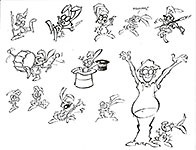 SINCE I’VE BEEN
CARETAKER of one of the long-eared critters almost all my life (“almost”
because I still have some yet to live), you’d think the Easter Bunny would have
attracted my analytical attention before now. But it hasn’t. And yet every year
we pass through another Easter, dying eggs and indulging a species of
cannibalism by eating chocolate bunnies. We look forward every year to the
arrival of this holiday, hoping that this year, we’ll see the Easter Bunny
suitably attired in red short pants, white three-finger gloves, and giant
yellow shoes. Our hope, of course, is in vain: the cotton-tailed leporidae
re-appears faithfully in fur and only fur from head to paws. SINCE I’VE BEEN
CARETAKER of one of the long-eared critters almost all my life (“almost”
because I still have some yet to live), you’d think the Easter Bunny would have
attracted my analytical attention before now. But it hasn’t. And yet every year
we pass through another Easter, dying eggs and indulging a species of
cannibalism by eating chocolate bunnies. We look forward every year to the
arrival of this holiday, hoping that this year, we’ll see the Easter Bunny
suitably attired in red short pants, white three-finger gloves, and giant
yellow shoes. Our hope, of course, is in vain: the cotton-tailed leporidae
re-appears faithfully in fur and only fur from head to paws.
This
year, however, the Easter Bunny came in at the back door during my spasm of
outrage that my church has surrendered to a spurious but apparently fashionable
brand of political religious correctness: they’ve started calling Easter by
another name—Resurrection Sunday—because, I assume, Easter is a word with a
pagan (or at least non-Christian) history that the Rectitudinally Faithful wish
to disassociate their pure religion from.
Naturally,
I deem this effort as not only misguided but misbegotten. “Easter,” the word as
well as the holiday, has a history, and to consign the word to Limbo is to deny
history—which, in this case, seems to me like denying the religion it’s
associated with.
The
history of a religion tells us a lot about the people—the societies—in which
the religion flourished. And vice versa: we learn a lot about religion by
examining its history.
In
Greek mythology (as good a religion as any in its day), Zeus, the patriarch of
the pantheon, had many wives. Why? The reason is hidden in the history of the
religion.
In
the earliest times, Zeus was the god of nomads who roamed and conquered their
region. The other occupants in the vicinity were agricultural societies that
survived and thrived by planting and harvesting crops. They worshiped a goddess
because the female of the species, giving birth to others of the species from
time to time, was seen as mysterious (no one had yet explained how human reproduction
worked) and therefore powerful. Women represented the fertility of the soil and
the fecundity of Nature.
When
the nomads wandered into a farming valley and conquered its occupants, they
needed to deal with the local goddess in some way that would appease the
agriculturists without discrediting their goddess or belittling their belief.
The best way to manage this was to have the two gods marry. Since the nomads
conquered several agricultural communities in succession, Zeus wound up with
several wives.
Many
religions had to settle a similar problem. The Jews resolved the matter by
discrediting the goddess, turning her into Eve who was responsible for Adam
being banished from the Garden of Eden. As Christianity spread from the Mideast
throughout the known world, it picked up pieces of pre-Christian (i.e.,
pagan—or, gasp, heathen!) culture as it went along. And “Easter” is a remnant
of that evolution.
To
get to the Easter Bunny, we must first plow through fragments of the history of
Easter. St. Wikipedia is our guide throughout, and I’ve quoted nearly verbatim
from several entries without crediting anyone (just as St. Wikipedia often
does).
To
begin with the touchstone that orients us to Easter itself: the argument of the New Testament is that the resurrection of Jesus is a foundation of the
Christian faith, and the resurrection is what Easter celebrates. But Easter
originally had nothing to do with Christ (although it did have something to do
with resurrection—the rebirth or resurrection of all Nature in the spring of
every year).
In
a holdover from those primitive agricultural societies, European pre-Christian
religions celebrated the fertility goddess Eostre (Ostara in continental
Europe).
The
modern English term Easter, cognate with modern Dutch ooster and
German Ostern, developed from an Old English word that usually appears
in the form Ēastrun, -on, or -an; but also as Ēastru, -o; and Ēastre or Ēostre. The most widely
accepted theory of the origin of the term is that it is derived from the name of
a goddess mentioned by a 7th/8th-century English monk named Bede, who wrote
that Ēosturmōnaþ (Old English 'Month of Ēostre',
translated in Bede's time as "Paschal month") was an English month
corresponding to April, which he says "was once called after a goddess of
theirs named Ēostre, in whose honor feasts were celebrated in that
month."
However,
saith St. Wikipedia, it is possible that Bede was only speculating about the
origin of the term since there is no firm evidence that such a goddess actually
existed.
Well,
okay. But how come, then, so many entries about Easter mention her? Perhaps the
mentions themselves constitute all the “firm evidence” of her existence there
is. Stranger things have happened.
In
any event, the reports claim that Eostre/Ostara was celebrated by pre-Christian
religions on the first day of spring (vernal equinox) because that is when the
days are getting notably longer than nights and the nature “wakes up.” Since
Christian celebration of Christ’s resurrection was roughly coincident with the
celebration of Eostre, the customs started mixing: “waking up” and
“resurrection” became rough equivalents, each reinforcing the other. And so
pre-Christian notions slowly became Christian ones. Just as Jewish notions
slowly became Christian ones.
In
Greek and Latin, the Christian celebration was, and still is, called
Πάσχα, Pascha, a word derived from Aramaic
פסחא, cognate to Hebrew
פֶּסַח (Pesach). The word originally
denoted the Jewish festival known in English as Passover, commemorating the
Jewish Exodus from slavery in Egypt. Already in the 50s of the 1st century, the
apostle Paul (who did more to create the Christian religion than anyone),
writing from Ephesus to the Christians in Corinth, applied the term to Christ,
and it is unlikely that the Ephesian and Corinthian Christians were the first
to hear Exodus 12 interpreted as speaking about the death of Jesus, not just
about the Jewish Passover ritual.
In
most of the non-English speaking world, the feast is known by names derived from
Greek and Latin Pascha. Pascha is also a name by which Jesus himself is
remembered in the Orthodox Church, especially in connection with his
resurrection and with the season of its celebration.
Easter
is linked to the Jewish Passover by much of its symbolism, as well as by its
position in the calendar. In many languages, the words for "Easter"
and "Passover" are identical or very similar. Easter customs vary
across the Christian world, and include sunrise services, exclaiming the Paschal
greeting, clipping the church, and decorating Easter eggs (symbols of the empty
tomb). The Easter lily, a symbol of the resurrection, traditionally decorates
the chancel area of churches on this day and for the rest of Eastertide.
Additional customs that have become associated with Easter and are observed by
both Christians and some non-Christians include egg hunting, the Easter Bunny,
and Easter parades. There are also various traditional Easter foods that vary
regionally.
Easter’s
link to the Passover and Exodus from Egypt is recorded in the Old Testament through
the Last Supper and the sufferings and crucifixion of Jesus that preceded the
resurrection. According to the New Testament, Jesus gave the Passover
meal a new meaning, when, in the upper room during the Last Supper, he prepared
himself and his disciples for his death. He identified the matzah and cup of
wine as his body soon to be sacrificed and his blood soon to be shed. Paul
states: "Get rid of the old yeast that you may be a new batch without
yeast—as you really are. For Christ, our Passover lamb, has been sacrificed.”
This refers to the Passover requirement to have no yeast in the house and to
the allegory of Jesus as the Paschal lamb.
One
interpretation of the Gospel of John is that Jesus, as the Passover lamb, was
crucified at roughly the same time as the Passover lambs were being slain in
the temple, on the afternoon of Nisan 14. The scriptural instructions specify
that the lamb is to be slain "between the two evenings," that is, at
twilight. By the Roman period, however, the sacrifices were performed in the
mid-afternoon.
This
interpretation, however, is inconsistent with the chronology in the Synoptic
Gospels. It assumes that text literally translated "the preparation of the
passover" in John 19:14 refers to Nisan 14 (Preparation Day for the
Passover) and not necessarily to Yom Shishi (Friday, Preparation Day for the
Passover week Sabbath) and that the priests' desire to be ritually pure in
order to "eat the passover" refers to eating the Passover lamb, not
to the public offerings made during the days of Unleavened Bread.
The
first Christians, Jewish and Gentile, were certainly aware of the Hebrew
calendar. Jewish Christians, the first to celebrate the resurrection of Jesus,
timed the observance in relation to Passover.
Direct
evidence for a more fully formed Christian festival of Pascha (Easter) begins
to appear in the mid-2nd century. Perhaps the earliest extant primary source
referring to Easter is a mid-2nd-century Paschal homily attributed to Melito of
Sardis, which characterizes the celebration as a well-established one. Evidence
for another kind of annual Christian festival, the commemoration of martyrs,
begins to appear at about the same time as does evidence for the celebration of
Easter.
Easter
and the holidays that are related to it are moveable feasts which do not fall
on a fixed date in the Gregorian or Julian calendars that follow only the cycle
of the sun; rather, its date is determined on a lunisolar calendar similar to
the Hebrew calendar. The First Council of Nicaea (convened by Emperor
Constantine in A.D.325) established two rules, independence of the Jewish
calendar and worldwide uniformity, which were the only rules for Easter
explicitly laid down by the Council. No details for the computation were
specified; these were worked out in practice, a process that took centuries and
generated a number of controversies, but Christian dignitaries decided that
from then on, Easter will be celebrated on the first Sunday after the full moon
in spring (i.e., after spring solstice) or soonest after March 21, but
calculations vary. (Full moon? How pagan is that?)
After
Nicaea, Constantine sent a charming letter to all Church fathers who were not
present at Council explaining that this decision was necessary because “… it is
our duty not to have anything in common with the murderers of our Lord [i.e.,
Jews].” Clearly a sort of afterthought: however much Constantine wanted to
divorce the Christian celebration from the Passover celebration of the Jews,
the two holidays remain, to this day, often convergent. At that time there was
no written mention of eggs or bunnies being in any way related to Easter. But
that was coming along.
The
more cultures that embrace an idea or are embraced by it, the more universal
and relevant to humanity in general a religion becomes—hence the value of
histories of religion with their long-forgotten fragments of bygone beliefs and
traditions, pagan, heathen, whatever we call them. Mashed-up together, they
embody our commonality.
The
Easter Bunny (at last)
The Easter
Bunny (also called the Easter Rabbit or Easter Hare) is a folkloric figure and
symbol of Easter, depicted as a rabbit bringing Easter eggs. 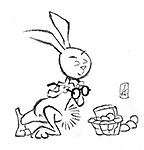 Originating among German
Lutherans, the "Easter Hare" initially played the role of a judge,
evaluating whether children were good or disobedient in behaviour at the start
of the season of Eastertide. Originating among German
Lutherans, the "Easter Hare" initially played the role of a judge,
evaluating whether children were good or disobedient in behaviour at the start
of the season of Eastertide.
The
Easter Bunny is sometimes depicted with clothes. In legend, the creature
carries colored eggs in his basket, candy, and sometimes also toys to the homes
of children, and as such shows similarities to Santa Claus or the Christkind,
as they both bring gifts to children on the night before their respective holidays.
The custom was first mentioned in Georg Franck von Franckenau's De ovis
paschalibus (“About Easter Eggs”) in 1682 (other sources cite 1678),
referring to a German tradition of an Easter Hare bringing Easter eggs for the
children.
The
role of eggs in celebrating Easter is shrouded in a tradition having to do with
diet. Orthodox churches have a custom of abstaining from eating eggs during the
fast of Lent. The only way to keep the uneaten eggs from being wasted was to
boil or roast them, eating later when breaking the fast.
As
a special dish, they would probably have been decorated as part of the
celebrations. Later, German Protestants retained the custom of eating colored
eggs for Easter, though they did not continue the tradition of fasting. Eggs
boiled with some flowers change their color, bringing the spring into the
homes, and some over time added the custom of decorating the eggs.
Many
Christians of the Eastern Orthodox Church to this day typically dye their
Easter eggs red, the color of blood, in recognition of the blood of the
sacrificed Christ—and of the renewal of life in springtime. Some also use the
color green, in honor of the new foliage emerging after the long-dead time of
winter. The Ukrainian art of decorating eggs for Easter, known as pysanky,
dates to ancient, pre-Christian times. Similar variants of this form of artwork
are seen amongst other eastern and central European cultures.
The
idea of an egg-giving hare was transported to the U.S. in the 18th century.
Protestant German immigrants in the Pennsylvania Dutch area told their children
about the "Osterhase" (sometimes spelled "Oschter
Haws"). Hase means "hare", not rabbit, and in Northwest
European folklore the "Easter Bunny" indeed is a hare. According to
the legend, only good children received gifts of colored eggs in the nests that
they made in their caps and bonnets before Easter.
In
ancient times, it was widely believed (as by Pliny, Plutarch, Philostratus, and
Aelian) that the hare was a hermaphrodite. The idea that a hare could reproduce
without loss of virginity led to an association with the Virgin Mary, with
hares sometimes occurring in illuminated manuscripts and Northern European
paintings of the Virgin and Christ Child. It may also have been associated with
the Holy Trinity, as in the three hares motif. Eggs, like rabbits and hares,
are fertility symbols of antiquity. Since birds lay eggs and rabbits and hares
give birth to large litters in the early spring, these became symbols of the
rising fertility of the earth at the Vernal Equinox.
Rabbits
and hares are both prolific breeders. Female hares can conceive a second litter
of offspring while still pregnant with the first. This phenomenon is known as
superfetation. Lagomorphs mature sexually at an early age and can give birth to
several litters a year (hence the saying, "to breed like rabbits" or
"to breed like bunnies"). It is therefore not surprising that rabbits
and hares should become fertility symbols, or that their springtime mating
antics should enter into Easter folklore.
In his 1835 Deutsche Mythologie, Jacob
Grimm (yes, that guy, of the Brothers Grimm and folktales galore) states
"The Easter Hare is unintelligible to me, but probably the hare was the
sacred animal of Ostara." This proposed association was repeated by other
authors including Charles Isaac Elton and Charles J Billson. In 1961 Christina
Hole wrote, "The hare was the sacred beast of Eastre (or Eostre), a Saxon
goddess of Spring and of the dawn." The belief that Ēostre had a hare
companion who became the Easter Bunny was popularized when it was presented as
fact in the BBC documentary “Shadow of the Hare” (1993, which seems a little
late in the game). But the Oxford Dictionary of English Folklore says
"... there is no shred of evidence" that hares were sacred to
Ēostre, noting that Bede does not associate her with any animal.
So
how did eggs get associated with the Eostre bunny? An old Teutonic myth says
that one Winter day the goddess Eostre was passing through a forest and found a
bird dying in snow from hunger and cold. The goddess turned the bird into a
rabbit because they have a warm fur and can find food more easily than any
bird. And so our bunny survived the winter and when the spring came, the animal
started laying eggs because it was once a bird. The rabbit then decorated every
egg leaving them to Eostre as a sign of gratitude. Hence the Easter egg hunt –
“the bunny left the eggs the night before” (wink, wink).
Rabbits
in Culture and Literature, Folklore and Myth
Rabbits are
often used as a symbol of fertility or rebirth, and have long been associated
with spring and Easter as the Easter Bunny. The species' role as an animal of
prey also makes it a symbol of innocence, another Easter connotation. They
appear in folklore and modern children's stories, often but not invariably as
sympathetic characters. Additionally, rabbits are often used as symbols of
playful sexuality, which also relates to the human perception of innocence, as
well as its reputation as a prolific breeder. The rabbit often appears in
folklore as the trickster archetype, who uses his cunning to outwit his
enemies.
◆ A rabbit's foot carried as an amulet believed to bring
good luck is found in many parts of the world, and with the earliest use being
in Europe around 600 B.C.
◆ In Aztec mythology, a pantheon of four hundred rabbit gods
known as Centzon Totochtin, led by Ometotchtli or Two Rabbit, represented
fertility, parties, and drunkenness.
◆ In Central Africa, the common hare (Kalulu), is
"inevitably described" as a trickster figure.
◆ In Chinese folklore, rabbits accompany Chang'e on the
Moon. Also associated with the Chinese New Year (or Lunar New Year), rabbits
are one of the twelve celestial animals in the Chinese Zodiac for the Chinese
calendar.
◆ A Vietnamese mythological story portrays the rabbit of
innocence and youthfulness. The Gods of the myth are shown to be hunting and
killing rabbits to show off their power. The Vietnamese lunar new year replaced
the rabbit with a cat in their calendar, as rabbits did not inhabit Vietnam.
◆ In Japanese tradition, rabbits live on the Moon where they
make mochi, the popular snack of mashed sticky rice. This comes from
interpreting the pattern of dark patches on the moon as a rabbit standing on
tiptoes on the left pounding on an usu, a Japanese mortar.
◆ In Korean mythology, as in Japanese, rabbits live on the
moon making rice cakes (teok in Korean).
◆ In Jewish folklore, rabbits (shfanim
שפנים) are associated with cowardice, a usage
still current in contemporary Israeli spoken Hebrew (similar to English
colloquial use of "chicken" to denote cowardice).
◆ In Anishinaabe traditional beliefs, held by the Ojibwe and
some other Native American peoples, Nanabozho, or Great Rabbit, is an important
deity related to the creation of the world.
◆ Among English speakers, the rabbit may be invoked at the
start of the month out of apotropaic or talismanic superstition.
On
the Isle of Portland in Dorset, England, the rabbit is said to be unlucky and
speaking its name can cause upset with older residents. This is thought to date
back to early times in the quarrying industry, where piles of extracted stone
not fit for sale were built into tall rough walls (to save space) directly
behind the working quarry face; the rabbit's natural tendency to burrow would
weaken these "walls" and cause collapse, often resulting in injuries
or even death.
The
word “rabbit” is often replaced with words such as “long ears” or “underground
mutton,” so as not to have to say the actual word and bring bad luck to
oneself. It is said that a public house (on the island) can be cleared of
people by calling out the word “rabbit,” and while this was very true in the
past, it has gradually become more fable than fact over the past 50 years.
Just
before that—about 62 years ago—I invented Harvey the Rabbit.
WELL, NOT
EXACTLY. Harvey the rabbit was the invention of Mary Coyle Chase, and for her,
the rabbit was lower case, and her Harvey, like mine, did not make mochi on the
moon or burrow under stone walls. He was something of an innocent rather than a
trickster, and although he was not himself a drunk, he associated with one.
Born
in 1906, Chase became a newspaper woman on the Rocky Mountain News in
Denver during the roaring twenties while she was still a teenager. In those
halcyon days of journalistic yore, reporters lived up to (because they created)
the stereotypical reputation of working long hours, drinking hard, and stopping
at nothing to beat the competition to a story. Running around Denver with
photographer Harry Rhoads in a Model T Ford, Chase recalled, "In the
course of a day, Harry and I might begin at the Police Court, go to a murder
trial at the West Side Court, cover a party in the evening at Mrs. Crawford
Hill's mansion, and rush to a shooting at 11pm."
Writing
under her maiden name, Mary Coyle, she started on the society pages of the News, but soon became a feature writer, reporting the news from a sob sister,
emotional angle, becoming part of the news itself as a comic figure, "our
Lil' Mary." She was also engaged in producing a cartoon feature, funny,
flapper era pieces as part of a series of "Charlie & Mary"
stories, for which Charlie Wunder drew the cartoons and Mary wrote the text.
In
1928, she married Robert L. Chase, a fellow reporter at the News. Bob
was a seasoned, "hard news" reporter, having worked at the Denver
Express since 1922, covering the robbery of the U.S. Mint and fighting
against the rise of the Ku Klux Klan in Colorado state and local politics. The Express eventually merged with the News, and Bob went on to a 47-year newspaper
career at the paper, becoming managing editor and then associate editor.
Mary
Chase’s passion, however, was the theater, and in 1930, she left the News after six years and began writing plays. Her fourth play was “Harvey,” whose
title character was a six-foot tall invisible white rabbit, who accompanied a
kindly dipsomaniac named Elwood P. Dowd wherever he went. Dowd, thoughtfully,
always carried Harvey’s hat and overcoat, flung over his arm.
Elwood
was a gentle, philosophical soul. “My mother,” he was wont to remember, “used
to say to me, ‘In this world, Elwood’—she always called me Elwood—she’d say, ‘In
this world, Elwood, you must be oh, so smart or oh, so pleasant.’ For years, I
was smart. I recommend pleasant. You may quote me.”
Elwood
may have been inspired by another Denver newspaperman, the somewhat eccentric
but talented, erudite and principled Lee Casey, who was a star reporter,
long-time columnist and even acting editor (for a couple of years) at the News. His obituary in 1951 when he died at 60, included this encomium:
“Whether
turning out hard-hitting—and courageously against the grain of the
times—columns defending the rights of Japanese Americans during World War II or
a 13-year-old Wyoming boy railroaded by the justice system, he wrote with a
power and direct simplicity that stemmed from a clear sense of right and wrong.
At the same time, he was an avid reader who could deliver beautiful pieces on
classical literature.”
He
was a regular at the Denver Press Club poker games and “couldn’t leave his
beloved job, or his beloved newspaper, behind, even after his death. His ashes
were interred in the marblework of the paper’s lobby in the building at 400 W.
Colfax Avenue. They were subsequently removed to Olinger Crown Hill Mortuary
and Cemetery when the News moved east to 101 W. Colfax in 2006.”
Chase’s
Elwood, however, was not a newspaperman. He was, as nearly as anyone can tell,
not employed. Except as a habitue of Charlie’s, a downtown saloon to which he
was apt at any moment to invite whomever he had just met to repair for a drink.
In these expeditions, Elwood was accompanied always by his imaginary friend
Harvey. Elwood explains:
“Harvey
and I sit in the bars and we have a drink or two and play the jukebox. Soon the
faces of the other people turn toward mine and smile. They are saying, ‘We
don’t know your name, Mister, but you’re a lovely fellow.’ Harvey and I warm
ourselves in all these golden moments. We have entered as strangers—soon we
have friends. They come over. They sit with us. They drink with us. They talk
to us.They tell about the big terrible things they have done. The big wonderful
things they will do. Their hopes, their regrets, their loves,
their hates. All very large because nobody ever brings anything small into a
bar. Then I introduce them to Harvey. And he is bigger and grander than
anything they offer me. When they leave, they leave impressed. The same people
seldom come back—but that’s envy. There’s a little bit of envy in the best of
us—too bad, isn’t it?”
Rumor
to the contrary notwithstanding, Chase’s Harvey is not, strictly speaking, a
rabbit. He’s a pooka. One of Chase’s characters looks up the definition:
“Pooka, from old Celtic mythology. A fairy spirit in animal form. Always very
large. The pooka appears here and there, now and then, to this one and that one
at his own caprice. A wise but mischievous creature. Very fond of rum-pots,
crack-pots ...”
The
plot of Chase’s play is simplicity itself. Elwood’s sister Veta, a somewhat
scatter-brained middle-aged woman, has wearied of living with her brother and
his imaginary friend, an eccentricity, she believes, that interferes with her
social life and that of her daughter, Myrtle Mae.
“With
that rabbit in the house, our friends never come to see us,” Veta complains.
“We have no social life. We have no life at all.”
She
decides to have Elwood committed to a rest home for the mentally infirm. She
takes Elwood to Chumley’s Rest, but an attendant misunderstands and thinks Veta
is the nutty one and takes her off for a nice warm bath.
The
mistaken identification is eventually resolved (Veta refers to the over-eager
attendant as a “white slaver” because of his behavior towards her and his white
coat—which she sees as the uniform of a white slaver), and Dr. Chumley offers
to inject Elwood with a serum that will cure him of his hallucination.
“You
won’t see this rabbit anymore,” Elwood is told. “You’ll see your
responsibilities, your duties...”
To
which Elwood responds: “I’m sure if you thought of it, Doctor, it must be a
very fine thing. And if I happen to run into anyone who needs it, I’ll be glad
to recommend it. For myself, I wouldn’t care for it.”
But
he soon agrees to the treatment because he always feels that Veta should have
everything she wants.
At
the last minute, however, she changes her mind because she can’t bear to alter
Elwood’s pleasant demeanor.
By
the end of the play, Elwood’s delusion has impinged upon the rest of the cast
to the extent that not only Veta but Dr. Chumley begin talking about Harvey as
if he were real and apparent to them.
Elwood
has won. As he has all along.
Earlier
in the play, one of Chumley’s assistants urges Elwood to face reality.
“Doctor,”
says Elwood, “I wrestled with reality for forty years, and I am happy to state
that I finally won out over it.”
In
the closing scene in the play, Elwood is by himself on stage, and the door of Chumley’s
office opens, seemingly by itself, and Elwood greets the invisible Harvey as he
(presumably) enters the reception area: “Where’ve you been? I’ve been looking
all over for you...”
They
walk out together.
And
we, like everyone else watching the proceedings, are convinced: Harvey is
there. Harvey is real.
COPYRIGHTED in
1943 as “The White Rabbit,” Chase’s play was copyrighted again as “Harvey” for
its opening on Broadway on November 1, 1944. It was a smash hit, running for
four and a half years, 1,775 performances, closing January 15, 1949. In the
history of Broadway productions (which stretches back to 1750 according to St.
Wikipedia), “Harvey” became the 35th longest-running show (musicals and plays);
if only plays are counted, the 6th longest-running play on Broadway, after
“Life With Father,” “Tobacco Road,” “Abie's Irish Rose,” “Deathtrap,” and
“Gemini.” A film version with James Stewart as Elwood debuted in 1950.
Frank
Fay, who originated the Elwood role, and Stewart were the most famous actors to
portray Elwood P. Dowd. Josephine Hull portrayed his increasingly concerned
(and socially obsessed) sister on Broadway originally, and won a Best
Supporting Actress Oscar in the film. Stewart was nominated for a Best Actor
Oscar but lost out to Jose Ferrer in the 1950 film version of "Cyrano de
Bergerac.” 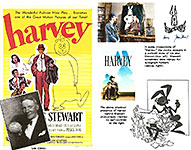
In
1945, Chase won the Pulitzer Prize in Drama for “Harvey.” In a field dominated
by men, Chase was the 4th woman to win the award; from 1917 to 2013, only 14
women have won the Pulitzer in Drama.
All
of which would come to nothing here at Rancid Raves had I not seen the “Harvey”
movie with Jimmy Stewart while I was in high school. Before I left Denver for
Kansas City in 1959, I’d also seen Joe E. Brown play Elwood P. Dowd in a Denver
theater. And in Kansas City ten years later while I was teaching English in
high school, I took a class of my students to a special dress rehearsal of the
play at the Union Station Theater.
The
Theater offered free tickets to high school classes to attend the dress
rehearsal performance because actors perform better when they have an audience.
I’d phoned in my request for a dozen tickets. When I went up to the ticket
booth to pick up the tickets, the lady at the counter asked under what name the
tickets were being held. I said, “Harvey,” and she said, “Oh, sure.”
I
and my students were the entire audience. It was theater-in-the-round, so we
were asked to spread out around the stage. We did.
During
the intermission, the actor playing Elwood came over and talked to me. He
wondered why they were getting laughs at places they didn’t expect to get
laughs. I explained that Harvey is my name and that my students laughed every
time they heard someone say my name on stage.
So
you might say I’ve had a long history with Harvey.
But
the Harvey the Rabbit that I invented came about in the fall of 1955 when I
started drawing cartoons for the campus humor magazine, The Flatiron, at
the University of Colorado in Boulder, where I was commencing my college
so-called career.
Those
were the days, my friends, when nights were filled with revelry and life was
but a song.

CAMPUS HUMOR
MAGAZINES were all the rage back when the twenties syncopated and colleges got
their reputations as habitats of licentious partying in bathtubs of gin. The
University of Colorado’s first humor magazine started in 1919 or 1920, as
nearly as I have been able to find out. Called The Dodo after an extinct
bird, it became extinct itself in about 1948 or 1949. But campus humor in
magazine form was revived a year later, christened The Flatiron, a much
better name.
The
magazine was named after a geological formation that cropped up in the
foothills at the edge of Boulder. Here is a visual aid. .jpg) The photo at the top is
of the actual flatiron geological oddity that makes a mountainous backdrop for
the U. of Colorado campus; there are five or six flatirons, depending upon how
you count/imagine. The picture at the bottom of this display is, as you
doubtless can tell, a joke. The photo at the top is
of the actual flatiron geological oddity that makes a mountainous backdrop for
the U. of Colorado campus; there are five or six flatirons, depending upon how
you count/imagine. The picture at the bottom of this display is, as you
doubtless can tell, a joke.
They’re
called "flatirons" because that's what they look like: for those who
are too young to remember flatirons, that's what my grandmother used to press
clothing with, a flat triangular slab of iron, heated over the stove or
fireplace. When not actually pressing clothing, the flatiron was stood up on
its end, the square bottom of the triangle, assuming a posture recalled by the
geological formation we've been contemplating.
The
next flatiron on view is the cover of the magazine with that name, the alleged
“humor” magazine at CU. 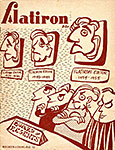 It was named after the geological formation but not because of any
kindred appearance; there is no resemblance. “Flatiron” was just a good word,
unique to the CU environs. This was the first I ever saw of The Flatiron magazine, the September 1955 issue. It was named after the geological formation but not because of any
kindred appearance; there is no resemblance. “Flatiron” was just a good word,
unique to the CU environs. This was the first I ever saw of The Flatiron magazine, the September 1955 issue.
I
picked up that September “Registration” issue while going through registration
that fall. To the best of my recollection, I had never heard of a college humor
magazine until then. I volunteered immediately to draw cartoons for it. The
editor, Jim Schaffner, might’ve been delighted: he’d just lost the “campus
cartoonist,” Annette Goodheart (“Netnet”), who’d graduated the previous spring.
Most
of the cartoons in the magazine were stolen from other campus humor magazines.
“Stolen” seems the most reliable source of cartoons in that “Registration”
issue. University humor magazines at the time were all part of a vast exchange
network, so everyone had access to everyone else’s magazine. And they borrowed
freely from each other. The quality of the drawing varied greatly—from raw
amateur to arty abstraction and, sometimes, surprising professional competence.
In
his editorial for this first issue of the school year, published in time to be
sold during registration that September, Schaffner wrote about the previous
year’s adventures:
“It
was a close one, but we made it. Last year’s ups and downs made us fear for the
life of The Flatiron. What with the banning, the Life magazine
publicity, the Tempest in the coffee-pot, and the threatened libel suits, we
thought there was a good chance that we would be put down for moral turpitude
(or inturpitude, whichever) or get called in front of the House somewhat
questionable activities committee. But, like we said, we made it. We are back
on the campus—no censorship, no troubles (yet), and nothing but the best in
campus humor.”
His
reference to “the Tempest” is to the disturbance caused by the visit to the
campus of Tempest Storm, a Denver stripper with a very large chest. As best I
can remember (and this incident happened before I was on campus so it’s all
hearsay here), a student photographer, Bob Latham—whose work often appeared in The
Flatiron—invited Tempest Storm to visit the campus (presumably for an
interview and a shoot, although neither, eventually, materialized), and she
walked across the quadrangle from Old Main to the University Memorial Center
(UMC)—the student union, which had just opened the year or so before.
It
was quite a long walk, and as she sashayed her way, she attracted considerable
attention from the male student population, which quickly turned into a
ravening mob, scrambling along in her wake. She entered the UMC through the
coffee shop, and the mob was so enthusiastic that the doors were torn off their
moorings as they passed through the portal. And that, in fact, was probably the
highlight—and the end—of the episode.
Other
references to the preceding year include an allusion to the banning of the
magazine. At the end of 1954, The Flatiron was banned on
campus—briefly—and then reinstated. The pre-banning issue was December 1954;
the resurrected issue, probably January or February 1955. There were three
issues that spring, a total of 6 issues for the school year.
Why
was it banned? Too much sex, probably. The editors no doubt felt they must
compete with Playboy, which had just—in December 1953—appeared; and the
editors were older guys with more experience at sex than most college students.
Judging from photos, the editors were probably ex-servicemen going to college
on the GI bill.
The
banning attracted national attention. Life magazine did a story on the
pin-up photos in The Flatiron’s first issues that school year—girls in
bikinis (or, in one case, reclining in front of a fireplace wearing a towel).
In one of the issues, there was also a short story recounting some sexual
activity between a man and a woman—lots of caressing and heavy breathing
reported. The publicity of Life’s coverage was doubtless enough to
convince the University’s Board of Regents to ban the magazine.
Why
it was reinstated—what allowed it to be reinstated so soon— is another
unanswered question. The culpable editor was fired and a new one installed. A
scapegoat having been sacrificed, The Flatiron was permitted to
re-emerge. The content of the reinstated magazine was not markedly different
except that there were no scantily-clad co-eds—except in the first issue’s
feature lampooning the Life coverage, which published again the
incriminating pin-up photos. As a joke, this time. 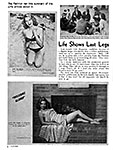
The
“House” committee Schaffner mentions is the nefarious House of Representatives’
Un-American Activities Committee, which had been skewering innocent passersby
for alleged subversive plots since 1938. During the McCarthy scandals of the
early 1950s, HUAC achieved a fresh notoriety.
Schaffner
had been associate editor under both 1954 editors and ascended to editorship in
the fall of 1955. He, like others of The Flatiron editors of the last
couple years, was older than the rest of us. I think he was probably a Korean
War vet going to college on the GI Bill.
I
don’t remember much about my relationship to the editor and his other minions.
To the best of my recollection, we never met in the magazine’s offices on the
fourth floor of the UMC. Some of what I drew, illustrations for short stories
or articles, was foisted off on me by the editor; but lots of the rest seems to
be concoctions of my own, probably propounded in the solitude of my dorm room
and turned in on spec.
One
issue, probably the second (and last) one I worked on, was assembled in the
basement of the Sig Ep (Sigma Phi Epsilon) fraternity house on Broadway. One of
Schaffner’s inner circle was a member there; Schaffner, as far as I know, was
not a member of any fraternity. We sat around a table to do our work. I can’t
remember if I drew cartoons right there, on the spot, or not. I suspect not,
but too many of the cartoons seem remnants of our so-called “editorial
deliberations” committed while we sat at the table, so maybe I drew some of
them right there.
As
far as I know, nothing ever happened in the office of The Flatiron. I
was in it only once or twice. I think the business staff might’ve operated out
of it, but the “creative” staff—mostly Schaffner—didn’t.
Schaffner
used to hawk Flatirons himself. As soon as an issue was published, he’d
take a chair out of the magazine’s office in the student union and put the
chair at the intersection of two busy sidewalks outside the building. He’d put
a stack of Flatirons on the chair, then, tucking a couple under one arm
and holding another in his outstretched hand, he’d croak: “Flatiron.
Getcher Flatiron here. Flatiron.” And on and on.
None
of the rest of us actually sold the magazine.
I DEBUTED in
the “Homecoming” issue of The Flatiron with the cover drawing posted
here, at the elbow of your eye. 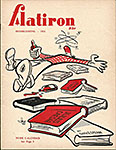 I never drew another picture like it. I was clearly
attempting a cartoon style akin to that on display on the cover of the
“Registration” issue. I didn’t think I was good at this style, so I reverted to
my customary manner in all the other cartoons in my inaugural issue. I never drew another picture like it. I was clearly
attempting a cartoon style akin to that on display on the cover of the
“Registration” issue. I didn’t think I was good at this style, so I reverted to
my customary manner in all the other cartoons in my inaugural issue.
Drink
was evidently a big deal for Homecoming: alcohol consumption persuaded our cover
personality to abandon all of Shakespeare. It was an apt if mischievous
interpretation of that year’s Homecoming theme that quoted the title of one of
the Bard’s plays, “As You Like It.” And that’s how we were presumed to like
Homecoming—dead drunk after a joyously inebriated weekend.
Until
I arrived at CU, I hadn’t much familiarity with alcohol. (Nor Shakespeare.)
Despite the rambunctious nature of my high school class, I hadn’t so much as
sipped a beer. That and other manifestations of my adolescent innocence would
disappear fairly fast, as you’ll see as we plunge ahead.
Among
my first contributions to the “Homecoming” issue of The Flatiron were
illustrations for articles, one of which we see nearby.
I’ve reproduced the
“Highway Hanagover” illo twice, the second time focusing on the drawing. And if
you peer just below the highway sign at the lower right, you’ll see a tiny
bespectacled rabbit, drinking from a bottle. That is the first appearance of
Harvey the Rabbit. I remember drawing this picture at my desk in my dorm room.
I
was rooming with Bert Benedick, who was a couple years older than I. He was a
very cool guy before cool was something everyone wanted to be. Very laid back.
How laid back? Well, herewith, an example.
I’d
pledged a fraternity that fall, Theta Xi, and in due course, I graduated from
pledge to active during the customary “Hell Week” initiation. During that week,
all us pledges lived at the fraternity house, where we were induced to perform
distasteful tasks and suffer other humiliations. And we lost a lot of sleep.
Come Saturday, I was desperate for sleep, so I cut my Saturday morning class
and went to my dorm room for nap.
The
dorm rooms were narrow and uniform. As you entered, you passed closets, one on
each side, right and left. Behind sliding doors, each closet had, in addition
to clothes rack, a small waist-high cabinet. Next, you passed a dresser on each
side, right and left; then beds. Then two desks next to the window.
I
stretched out on the bed and promptly fell asleep. A few minutes later, I was
awakened by voices seemingly coming down the hall to my room. In a drowsy
stupor, I thought I heard the voices of some of my fraternity brothers, who
were doubtless patrolling the dorms to find runaway pledges like me sneaking a
nap.
I
jumped out of bed and, desperate for a place to hide if they came into the
room, I made for my closet and slid open the sliding door. Alas, it opened not
on the clothes rack section but on the little cabinet section. Nothing daunted,
I climbed on top of the cabinet and was trying to close the sliding door on
myself when the door to the room opened and Bert walked in.
He
said nothing in recognition of the peculiar sight he saw—me, whom he hadn’t
seen for a week, crouched atop the cabinet in my closet, trying to shut the
sliding door on myself.
He
just walked by, nodded hello, and went to his desk. I sheepishly climbed off my
perch and shut the sliding door.
That’s
how cool Bert was. Imperturbable. Absolutely.
Another
cool time—:
He
and I went drinking in Denver one evening with a couple friends. We went to the
Outrigger, a bar in the Cosmopolitan Hotel that was patterned after South
Pacific island village dwellings—all bamboo and thatch decor. Trader Vic’s took
over the motif in countless locations across the nation, but at the time, the
Outrigger was its own invention.
Once
we were seated at a table, the waitress came by for our orders, and she started
by asking for ID. Panic. I was underage. Bert was not. He gave her his ID, she
looked at it and returned it, then proceeded around the table. As she worked
her way around, Bert, seated across from me, slipped me his ID, so when she got
to me, I gave her Bert’s ID.
This
was tricky. When she’d first inspected his ID when he’d given it to her, she
returned it and said, “Thank you, Bert.” When she returned it to me, she said,
“Thank you, Benedick.”
Undoubtedly,
she knew.
But
the story illustrates Bert’s unflappable as well as resourceful personality.
IT WAS BACK IN
OUR DORM ROOM at another time altogether that I’d first drawn Harvey the
Rabbit, deploying the tiny symbol as my “signature.” What had prompted me to
resort to a symbol instead of my name, I have no specific inkling.
Mary
Chase’s Harvey was clearly in my mind. And her play and the movie and the name
of the six-foot pooka were still high in public consciousness. So “Harvey the
Rabbit” was a phrase everyone was attuned to. Looking at a rabbit, you might
think “Harvey.”
That,
at least, was my strategy in adopting a rabbit with spectacles (because I wear
them) as my signature. But the steps in my thought processes arriving at this
device I cannot recall.
I
remember in the sixth grade being fascinated by Fred O. Seibel’s signature
crow. We were subjected to a current events newspaper called The Weekly
Reader (or some such), and most issues carried a political cartoon by
Seibel, who was the editorial cartoonist at the Richmond Times Dispatch,
and he signed his cartoons with a diminutive crow—“Jim Crow,” Seibel called it.
Later, once the civil rights movement began to move, he changed the crow’s name
to Moses. 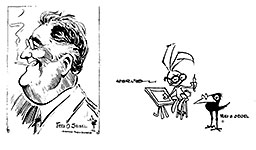
Seibel’s
crow was probably in the back of my mind. But who knows for sure? Not me.
These
signature devices (technially termed “dingbats”) were often deployed by
editoonists. Perhaps the most famous is Pat Oliphant, whose dingbat is a
penguin named Punk. And you might be tempted to suppose my Rabbit was inspired
by Oliphant’s Punk. Not so. Oliphant, an Australian, worked at the Denver
Post, so proximity suggests that your supposition is logical. But
impossible: I had invented Cahoots in the fall of 1955, ten years before
Oliphant arrived at the Post in 1965. I met Oliphant years later, and on
the basis of my Rabbit, I persuaded him to draw Punk for me. 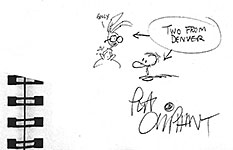
My
rabbit, whom I now call “Cahoots” (but that’s not his name: his name is still,
forever, Harvey, of course), did not appear on every cartoon I drew for the
“Homecoming” issue of The Flatiron that fall. I invented him halfway
through my labors for that issue. The issue’s cover, for instance, was drawn
after I’d happened on the Rabbit; so, he appears thereon.
While
he often appears as he does in that cover drawing—as a disembodied head—I tried
to use him at full diminutive figure in some way that commented on the action
of the cartoon he appeared in. And when I couldn’t think of anything for him to
do, I tried to hide him in some nearly conspicuous manner. Hereabouts are some
samples.
Among
them is another of my illustration assignments, a poem, “Sweet Ginny” by
someone called Metz. I don’t know where the poem came from or who Metz was/is.
Schaffner just handed me the poem, and I drew pictures of Sweet Ginny. And
stuck the Rabbit in amongst the crowd of her admirers.
At
last, among the accompanying examples, we get to the beating heart of the
exercise— drawing sexy babes, er, pretty girls. The excuse in one was
decorating a bookplate; the bookplate appeared amid several quarter-page ads
(genuine revenue-producing ads), and the supposition was that interested
parties could cut the bookplate out of the magazine and paste into their
textbooks. Probably my invention. But I certainly didn’t expect anyone to
actually scissor this overheated portrait out of the magazine. Bookplates were
not my chief preoccupation in doing this drawing. And in this Work of Art, the
influence of Mad’s Wally Wood is evident—legs and chest. In my
humble opinion, this is the best rendering of a pretty girl in this issue.
I
drew the cover and cartoons for the next issue of The Flatiron, too. It
was destined to be the last issue of the magazine. It was banned. Again. Beaten
to death by the Bored (as we said) of Publications, a faculty-student body.
Just as in that previous instance, it was banned presumably for its emphasis on
sex and alcohol. And I was carrying on in that nefarious tradition as you can
readily tell. 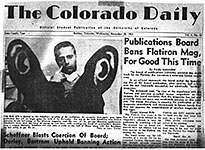
Because
of its scandalous history, The Flatiron was a lightning rod for criticism.
The reviewer on the campus newspaper, Roger Davidson, greeted this new Flatiron with this: “The nationally famed ‘folio of filth’ is filthier than ever as the
late lamented staff again has the notion that sex and humor are synonymous. ...
The failure of this Flatiron, as of all preceding issues, is the failure
of its staff to recognize and write real humor. The blatant fallacious
assumption that sex and humor are synonymous has merely been at the expense of
students who desire a good humor magazine on campus. We would advise students
to buy this issue, however, because it may be the last in a long time. Keep the
copies for a few years, and one may be able to get a good price from them as
relics!”
Prophetic,
as it turned out.
His
review of the previous issue—the one in which me and my Rabbit debuted—had
called it “clean as a bar of soap and fit to be displayed at a ladies’ aid
tea.” He might have added “and dull as dish water.” Roger had complimentary
things to say about some of the individual features of that issue, but in
summarizing, he wasn’t any happier over-all with this issue than he would be
with the next one. Said he: “One of the least objectionable issues in a long
time, it is also one of the least funny.”
He
also called “the work of rookie cartoonist Bob Harvey ... a bright spot in the
issue. Harvey’s evident mastery of the skill coupled with a wry sense of humor
contribute much to making the Flatiron almost worth a quarter.” Almost. And he
took notice of the Rabbit, which “distinguished” my work.
It
is the only time I can remember that my cartooning received a review. By name.
As
noted above, Roger did not mention either me or the Rabbit in condemning the
“Thanksgiving” issue as a “folio of filth.” (Roger, incidentally, eventually
married a cohort of mine, Nancy Davidson, whom you will meet in a trice.)
Others
on campus that fall of 1955 were less perturbed. One member of the student
governing body said: “I think it’s the best issue this year by a long shot.”
Another member of that august group agreed, sort of: “Even though it is a
little crude, this must be what the students want because it sold out.”
The Denver Post also slammed the “Thanksgiving” issue, calling it
“depressing” and adding:
“It’s
a sad effort and an utter waste of some nice, slik paper. The jokes (mostly
limericks and captions) are so hoary that grandpappy quit scribbling them on
the privy walls about the time he first went courtin’. Even so, they succeed,
along with Flatiron’s finger-painting caliber of art work, in being
stupidly gauche, even in misquotation or deliberate alteration. [The second
review of my cartooning but this time without naming names.]
“Nothing,”
the editorial went on, “is more pathetic than the adolescent trying to affect a
sophistication that is not yet his. That’s why The Flatiron, and its
sell-out, are both sad.”
The Post’s editorial went on to wonder whether the publication has not “put
the university itself in hazard” because it might inspire some kind of
disciplinary action. Probably should, in the Post’s estimation: “If this
is the literature, hardly of higher standard than the most berated comics, that
appeals to the taste of the C.U. student body, why is that student body itself
so tasteless?”
The
editorial finished by suggesting that Colorado taxpayers, once alerted to the
content of The Flatiron, may decide that their state-funded University
in fostering such a disgrace wasn’t worth their investment. “They may think
they are wasting their dough on a lot of young dolts who might better be
spending their time in army barracks and schools that train young ladies in how
properly to wait tables” instead of attempting to develop the youth of the
state into intelligent men and women ... citizens of more discrimination than
pool-hall loafers and hoodlums.”
After
that ejaculation, no wonder the magazine was banned. No public-funded
institution can long survive this kind of barrage.
At
the Colorado Daily on campus, reporter Duane Davidson wrote: “One of the
reasons for the abolition of The Flatiron was the embarrassment it had
caused the University recently, said Don Harlan, commission of publications. He
pointed out that embarrassing publicity of this type hampers the University’s
efforts in obtaining development funds.”
That
did it. The university’s reputation had been besmirched by its humor magazine.
And anytime you mention taxpayers in connection with a public university,
something happens.
In
the immediate aftermath of the Post editorial, members of the
university’s Board of Publications were non-committal in public. Maybe The
Flatiron would be banned; maybe not. But as soon as that body met, it
acted: it banned The Flatiron forever and ever, recommending that
“future Boards not approve the establishment of another magazine of this type.”
AT ONCE, THE
REDOUBTABLE EDITOR of that shameful rag, Jim Schaffner, philosophy major from
Highland Park, Illinois, responded. His reaction to Davidson’s criticism and to
the Post editorial was, in effect, to agree. But his agreement was a
rhetorical argument.
He
attended the Board of Publications meeting at which it was banned, and he
agreed with the Board’s decision. The “Thanksgiving” issue, he said, “stunk.”
“It
was a terrible issue,” he later explained. “I couldn’t put out a magazine that
would sell that I would be proud of.”
His
rhetoric implied a choice: publish an issue he could be proud of or an issue
that would sell. One or the other. Both were impossible.
He
pointed out that the “Homecoming” issue, a “clean” issue, sold only about 2,000
of its 3,500 press run. The “Thanksgiving” issue sold out. It was clearly “what
the students wanted.”
Soon
after the ban was announced, Schaffner let loose, continuing a long-running
feud with the university’s public relations guy, Jack Bartram.
“I
was charged with a responsibility that was impossible to discharge,” Schaffner
said. “I couldn’t please both Jack Bartram and the student body.”
Schaffner
charged that the magazine was banned as part of the University’s long-running
program of “education by public relations”:
“Bartram’s
job is to keep derogatory junk out of the Denver smut sheets so that the
legislature has a rosy view of things in Boulder.”
I’m
surprised, now—60-some years later—at how tough-minded Schaffner was. And how
out-spoken.
Of
the Post’s editorial that had probably precipitated the decision to ban
the magazine (the editorial was discussed at length at the Board meeting
although members of the Board said the editorial was not the reason The
Flatiron was banned), Schaffner said: “This University had great press
relations before Bartram was put to work as the moral FBI of the campus.
Obviously he alienates the press, provoking them to attacking the University.
It is easy to blame The Flatiron. It’s a patsy.
“We
suspect,” he went on, “that Bartram employed some mysterious coercion method to
the Board of Publications. There is no room for freedom of the press and
Bartram in the same place.”
Schaffner
had rubbed Bartram wrong the year before: “Last year I wrote a story blasting
Ward Darley [University President] for education by public relations. Soon
after I was brought to understand that this insidious trend at the University
is not Darley’s work. Darley is principled.”
Darley
issued a statement saying he had been “strongly in favor of banning The
Flatiron ever since the Thanksgiving issue came out.”
All
campus publications—the newspaper and the literary magazine, ept, enjoyed
freedom of the press. No faculty advisor sat in on editorial meetings to
approve or disapprove. In other words, no pre-publication censorship; but if a
publication produced something that earned the ire of the administration, it
could expect reprisals.
The
student governing body, the 13 commissioners of the Associated Students of the
University of Colorado (ASUC), backed the Board’s decision, but only after a
heated 3-hour debate over a resolution recommending that the University’s Board
of Regents review the banning decision and reinstate The Flatiron. The
resolution was introduced by Bill Hopkins, commissioner of entertainment and
the arts, who said his resolution was not intended as a defense of The
Flatiron but “a defense and a statement of our responsibility to defend the
rights and represent the wishes of the student body.”
He
questioned whether the Board of Publications had the right to ban a University
publication.
He
also pointed out that the magazine had sold out its “Thanksgiving” issue,
indicating that the content of that issue was what the student body wanted, and
it was therefore incumbent on ASUC, as elected representatives of the student
body, to recommend the magazine’s revival.
As
for the Board’s recommendation that it never approve in the future a magazine
of The Flatiron’s “type,” the commissioner of publications indicated
that a clarification would be issued. What was banned, he said, was The
Flatiron “as it is now. This does not mean that we can’t have a humor
magazine.”
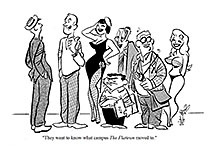 Good
thing, too: as it eventuated, I was involved with two subsequent attempts to
revive a campus magazine. To gain approval, we steered clear of the word
“humor,” speaking only of a “general interest” magazine. But whatever we called
it, it would have cartoons—on the cover and within. But that’s a story for
another day (specifically, in Rants & Raves, Opus 366, later
this month; all part of our celebration at completing 18 years at this post).
Before we leave the premises, however, here’s a cartoon that appeared in the
first issue of the first revival. Clearly, The Flatiron was a long time
expiring. I’m surprised we got away with it. Good
thing, too: as it eventuated, I was involved with two subsequent attempts to
revive a campus magazine. To gain approval, we steered clear of the word
“humor,” speaking only of a “general interest” magazine. But whatever we called
it, it would have cartoons—on the cover and within. But that’s a story for
another day (specifically, in Rants & Raves, Opus 366, later
this month; all part of our celebration at completing 18 years at this post).
Before we leave the premises, however, here’s a cartoon that appeared in the
first issue of the first revival. Clearly, The Flatiron was a long time
expiring. I’m surprised we got away with it.
NO OFFICIAL
BODY (or unofficial one) claimed my cartoons were culpable. So I wasn’t to
blame for the banning. Not by name anyway. But I can’t help but think my cover
cartoon must’ve had something to do with it. 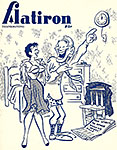 Not to mention others of my cartoons, two of
which are posted just a little further down this scroll. Thanks to the cover
drawing of the disrobing damsel, the cover oozes sex. But it’s a political
cartoon, not just a comedic one. Not to mention others of my cartoons, two of
which are posted just a little further down this scroll. Thanks to the cover
drawing of the disrobing damsel, the cover oozes sex. But it’s a political
cartoon, not just a comedic one.
The
ASUC had endorsed the idea of no curfew hours for senior women, an
unprecedented proposition. But sensible. Even in those distant days in which
educational institutions were severely in loco parentis, it was hard to justify
telling women who were 21 years old and older when they had to be in their dorm
rooms every night.
Once
the curfew for senior women was abandoned, senior women could stay out all
night if they wished. And it was assumed by all and sundry that senior women
would spent the night canoodling and sleeping around—the logical outcome if you
don’t make them come home at a decent hour at night. No hours = canoodling. The
cartoon visualizes the absurdity of this A=B equation, and, hopefully, by
visualizing it, ridicules it.
That,
in any case, is how I read it now.
Back
then, though, I bought the so-called logic of the equation: clearly, as anyone
looking at this cartoon could tell, if senior women had no curfew, they’d be
taking their clothes off and canoodling. The scales had fallen from my eyes,
and I saw, suddenly, the entire campus swarming with rutting students. Having
led an astonishingly innocent adolescence, I found this shocking. The cartoon
expressed my shock. And other cartoons in this, the “Thanksgiving” issue of The
Flatiron, did the same.
In
one of them— thankfully (for the “Thanksgiving” issue of The Flatiron)—
we get to a specimen that I think is funny. Well, the concept—a paperdoll
pin-up—is funny. And all the cut-out costumes actually fit over the “doll.” The
action progresses through the costumes, from the near nudity of the model to
the animated exaggerated lust of the guy at the lower left to the negligee of
the bedroom scene at the lower right—ending with my Rabbit (who has the
decency, alone among us, to blush).
It’s
easy to see why The Flatiron was banned as a result of this issue: the
Board of Publications was against sex. In common with most American adulthood,
they didn’t want us to know about sex. If we knew about it, we might (heaven
forfend!) do it. Meanwhile, I, coming from a small town at the western edge of
Denver (22 in my graduating class), was hearing more about sex than I’d heard
about before in my sheltered teenage life. It seemed to be everywhere. And so
it got into my cartoons, too.
I
marked the passing of The Flatiron with an editoon in the Colorado
Daily. 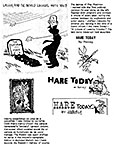
One
concluding note on the banning, and then I’ll abandon the subject forever. I
used to say, in jest, that while the banning oppressors of The Flatiron didn’t
say my cartoons contributed to the banning, it would be hard to deny that: of
the 32 pages of the magazine, 10 pages were ads, and of the remaining 22 pages,
17 were my cartoons. By the preponderance of the evidence, my cartoons
undeniably contributed to the downfall of The Flatiron.
But,
as usual, I was exaggerating.
The
“Homecoming” issue had 11 pages of advertising (counting full pages,
half-pages, and quarter pages); the “Thanksgiving” issue, 10 pages of ads.
In
the “Homecoming” issue—the “clean” issue— my cartoons (including the cover)
took 9 of the remaining 21 pages; in the “Thanksgiving” issue, the subsequently
banned issue, 7 1/4 of the remaining 22 pages. Of the editorial
(non-advertising pages), my cartoons were 42% of the “Homecoming” issue; 33% of
the banned “Thanksgiving” issue. By straight math, my cartoons contributed less
to the banned issue than they did to the preceding “clean” issue.
But
then, the Board of Publications wasn’t doing straight math. If it was doing
anything straight, it was straight crucifixion, and I’m sure my cartoons contributed
more than their numerical share to the provocation.

ONCE THE
FLATIRON WAS DEFUNCT, I was ostensibly out of business as a campus
cartoonist. But I found ways of soldiering on—drawing posters, for instance,
and doing Al Hirschfeld-like drawings about campus theatrical productions, and
covers for football programs and the season’s playing schedule, and other
events.
In
all of them, my Rabbit lurked. I seldom signed my name, but Cahoots was always
there. In one of the Homecoming football program covers, for 1956, the Rabbit
doesn’t appear, but the chubby waterboy is wearing a rabbit’s foot on his
keychain. Canny.
And
when I did the cover for the vest-pocket-size football schedule, I drew a
menacing buffalo football player charging along. The buffalo—the Golden
Buffalo—was the school mascot. No Rabbit in the drawing though: it would have
diminished the spectacle of the stampeding buffalo. I’d managed a nifty
anthropomorphization of the beast, I thought. And someone in the Athletic
Department apparently agreed: they used the drawing again the next year. After
that, it sank forever, never to surface again, leaving CU with only drab
silhouettes o personify the hump-backed mascot. 
And
I drew a few cartoons for my fraternity’s magazine (and included the Rabbit). I
stopped after just a few because they were reproduced so small. Besides, I’d
found other ways to waste my time.
Chief
among them, writing columns for the Colorado Daily. The first was a
humor/gossip enterprise called Hare Today. And that led to my co-writing
the campus society/gossip column, Carousel, with Nancy Davidson. In
order to keep up on the latest social movements (which in those days, were
generally gauged by how high you raised your elbow), we tried to inspect as
many parties on Friday and Saturday nights as possible. For that purpose, I
invented an alter ego, Dunston Barswig, who wore a red-, white- and
blue-striped blazer as a disguise.
With
Dunston and the Rabbit on my record, it’s pretty clear that I was trying not to
be conspicuous because I was always hiding under another identity.
I
also ran for student government, the 13-person ASUC commission. But if you look
at the poster by which I promoted my candidacy, it’s pretty clear that the
Rabbit was running, not me. After all, he was better known than I. Because the
ballots were counted by an arcane method known as the Hare System, I didn’t
win. My fraternity brothers celebrated at lunch the next day, serandading me
with an a cappella rendition of a popular song of the day, “He was a big man
yesterday, but, ooooh, you oughta see him now.”
People
told me they enjoyed the Rabbit: one friend told me that looking for the Rabbit
in one of my cartoons was like watching for the Hitchcock appearance in one of
his movies.
The
Rabbit and I came out of supposed retirement a couple times after graduation
for class reunions (as celebrated among the cartoons posted above). For the 50th reunion, I had Cahoots looking in a hand-mirror and making a remark alluding to
mortality. The Rabbit made it to the final version, but his remark was excised
as being in bad taste. The people doing the excising were lots younger than me
and my classmates, who, due to increasing infirmities, were all more likely to
find humor in the Rabbit’s comment.
A
few months ago I ran across fragments of a memoir whose note about mortality I
jotted down and saved: "I’ve never felt quite this mortal. It’s a
beautiful word, ‘mortal,’ rhyming with ‘portal,’ which sounds optimistic. And
really, who wants to live forever? How tedious life would become. Mortality
makes everything matter, keeps life interesting. And that’s all I ask."
I gave
up the Rabbit when I started cartooning in the Navy; but that’s another story
for another time. (Briefly—Cahoots regarded the Navy as a fleeting thing and
wouldn’t commit to wearing a uniform for so meager a duration.)
When
in 1978 I returned to gag cartooning for magazines, I abandoned Cahoots. I was
aiming to sell to all sorts of magazines—“general interest” on one hand, and,
on the other, “men’s” magazines. Among the latter, Playboy was the
highest payer. I always sent my cartoons to Playboy first; after being
rejected there (always), I sent them to the next highest-paying magazine, and
so on down a list of ever-diminishing monetary rewards until I finally reached Sex
to Sexty in Texas, which paid $5/cartoon.
I
didn’t have to be a rocket surgeon even in those pre-Sputnik days to suspect
that Playboy wouldn’t buy a cartoon signed with a rabbit: I would be
accused of trying to insinuate myself into the magazine by aping (or mocking?) Playboy’s institutional rabbit. If published, a rabbit-signed cartoon 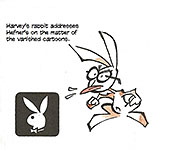 would seem like
nepotism of some kind. Or incest. And if I tried to sell Rabbit-signed cartoons
to other magazines, all Playboy imitators, my submissions would
obviously make to headway at all. All of these alternatives strenuously implied
I shouldn’t sign my cartoons with my Rabbit. So I didn’t. would seem like
nepotism of some kind. Or incest. And if I tried to sell Rabbit-signed cartoons
to other magazines, all Playboy imitators, my submissions would
obviously make to headway at all. All of these alternatives strenuously implied
I shouldn’t sign my cartoons with my Rabbit. So I didn’t.
It
wasn’t until I launched this Website in 1999 that I again found employment for
Harvey the Rabbit as a sort of ethereal mascot. And then a couple years ago, I
found a special assignment for Cahoots, as you can see in our concluding
cartoon.
Return to Harv's Hindsights |